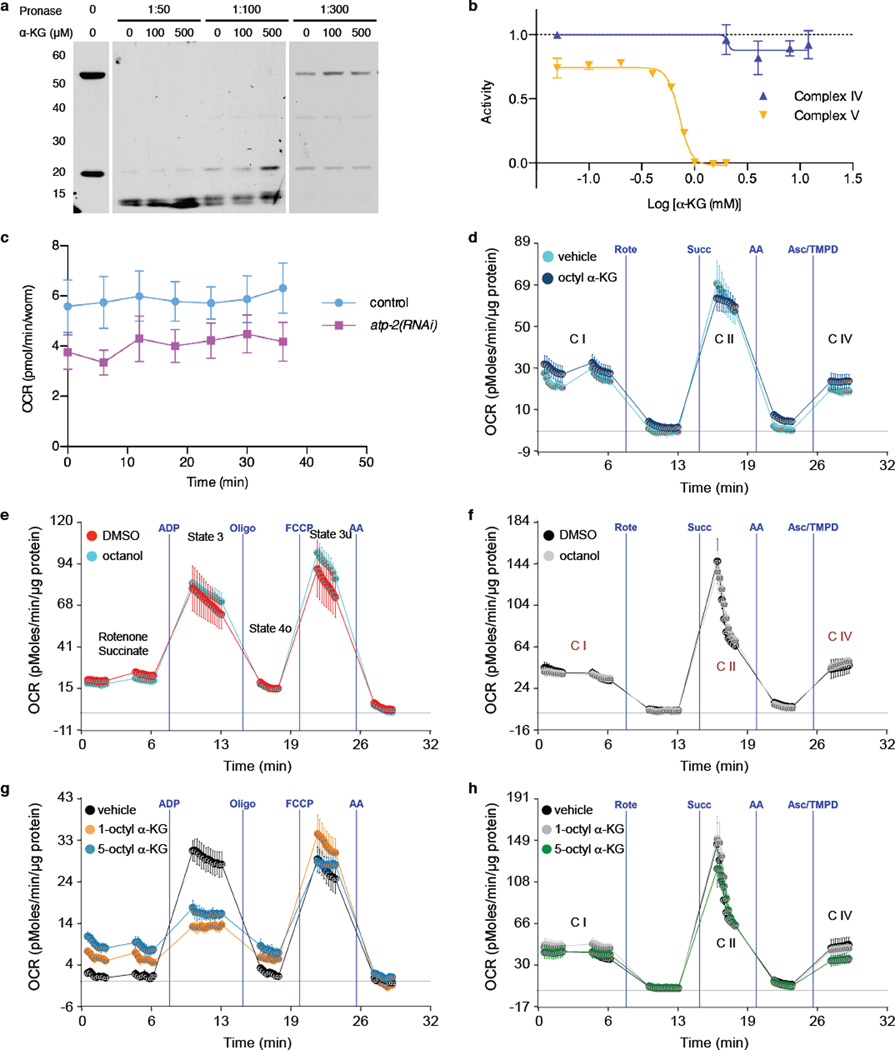
| PMC full text: | Nature. Author manuscript; available in PMC 2014 Dec 11. Published in final edited form as: | << PrevNext >> |
Extended Data Figure 2

a, Western blot showing protection of the ATP-2 protein from Pronase digestion upon α-KG binding in the DARTS assay. The antibody for human ATP5B (Sigma, AV48185) recognizes the epitope 144IMNVIGEPIDERGPIKTKQFAPIHAEAPEFMEMSVEQEILVTGIKVVDLL193 that has 90% identity to the C. elegans ATP-2. The lower molecular weight band near 20 kDa is a proteolytic fragment of the full-length protein corresponding to the domain directly bound by α-KG. b, α-KG does not affect Complex IV activity. Complex IV activity was assayed using the MitoTox OXPHOS Complex IV Activity Kit (Abcam, ab109906). Relative complex IV activity was compared to vehicle (H2O) controls. Potassium cyanide (Sigma, 60178) was used as a positive control for the assay. Complex V activity was assayed using the MitoTox Complex V OXPHOS Activity Microplate Assay (Abcam, ab109907). c, atp-2(RNAi) worms have lower oxygen consumption compared to control (gfp in RNAi vector), P < 0.0001 (t-test, two-tailed, two-sample unequal variance) for the entire time series (2 independent experiments); similar to α-KG treated worms shown in figure 2g. d, α-KG does not affect the electron flow through the electron transport chain. OCR from isolated mouse liver mitochondria at basal (pyruvate and malate as Complex I substrate and Complex II inhibitor, respectively, in presence of FCCP) and in response to sequential injection of rotenone (Rote; Complex I inhibitor), succinate (Succ; Complex II substrate), antimycin A (AA; complex III inhibitor), ascorbate / tetramethylphenylenediamine (Asc/TMPD; cytochrome c (Complex IV) substrate). No difference in Complex I (C I), Complex II (C II), or Complex IV (C IV) respiration was observed after 30 min treatment with 800 µM of octyl α-KG, whereas Complex V was inhibited (see Fig. 2h) by the same treatment (2 independent experiments). e-f, No significant difference in coupling (e) or electron flow (f) was observed with either octanol or DMSO vehicle control. g-h, Treatment with 1-octyl α-KG or 5-octyl α-KG gave identical results in coupling (g) or electron flow (h) assays. Mean ± s.d. is plotted in all cases.



